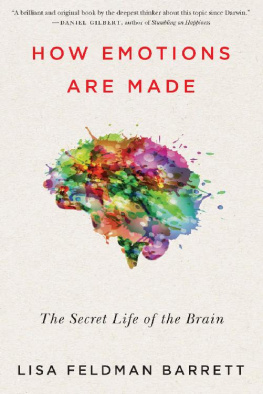Copyright 2017 by Lisa Feldman Barrett
Illustrations by Aaron Scott
All rights reserved
For information about permission to reproduce selections from this book, write to or to Permissions, Houghton Mifflin Harcourt Publishing Company, 3 Park Avenue, 19th Floor, New York, New York 10016.
www.hmhco.com
Library of Congress Cataloging-in-Publication Data is available.
ISBN 978-0-544-13331-0
Cover design by David Drummond
Cover image based on Shutterstock
e ISBN 978-0-544-12996-2
v1.0217
For Sophia
Introduction:
The Two-Thousand-Year-Old Assumption
On December 14, 2012, the deadliest school shooting in U.S. history took place at Sandy Hook Elementary School in Newtown, Connecticut. Twenty-six people inside the school, including twenty children, were massacred by a lone gunman. Several weeks after this horror, I watched the governor of Connecticut, Dannel Malloy, give his annual State of the State speech on television. He spoke in a strong and animated voice for the first three minutes, thanking individuals for their service. And then he began to address the Newtown tragedy:
We have all walked a very long and very dark road together. What befell Newtown is not something we thought possible in any of Connecticuts beautiful towns or cities. And yet, in the midst of one of the worst days in our history, we also saw the best of our state. Teachers and a therapist that sacrificed their lives protecting students.
As the governor spoke the last two words, protecting students, his voice caught in his throat ever so slightly. If you werent paying close attention, you might have missed it. But that tiny waver devastated me. My stomach instantly knotted into a ball. My eyes flooded. The TV camera panned to the crowd where other people had started to sob too. As for Governor Malloy, he stopped speaking and was gazing downward.
Emotions like Governor Malloys and mine seem primalhardwired into us, reflexively deployed, shared with all our fellow humans. When triggered, they seem to unleash themselves in each of us in basically the same way. My sadness was like Governor Malloys sadness was like the crowds sadness.
Humanity has understood sadness and other emotions in this way for over two thousand years. But at the same time, if humanity has learned anything from centuries of scientific discovery, its that things arent always what they appear to be.
The time-honored story of emotion goes something like this: We all have emotions built-in from birth. They are distinct, recognizable phenomena inside us. When something happens in the world, whether its a gunshot or a flirtatious glance, our emotions come on quickly and automatically, as if someone has flipped a switch. We broadcast emotions on our faces by way of smiles, frowns, scowls, and other characteristic expressions that anyone can easily recognize. Our voices reveal our emotions through laughter, shouts, and cries. Our body posture betrays our feelings with every gesture and slouch.
Modern science has an account that fits this story, which I call the classical view of emotion. According to this view, the waver in Governor Malloys voice launched a chain reaction that began in my brain. A particular set of neuronscall it the sadness circuitleaped into action and caused my face and body to respond in a certain, specific way. My brow furrowed, I frowned, my shoulders stooped, and I cried. This proposed circuit also triggered physical changes inside my body, causing my heart rate and breathing to speed up, my sweat glands to activate, and my blood vessels to constrict. This collection of movements on the inside and outside of my body are said to be like a fingerprint that uniquely identifies sadness, much like your own fingerprints uniquely identify you.
The classical view of emotion holds that we have many such emotion circuits in our brains, and each is said to cause a distinct set of changes, that is, a fingerprint. Perhaps an annoying coworker triggers your anger neurons, so your blood pressure rises; you scowl, yell, and feel the heat of fury. Or an alarming news story triggers your fear neurons, so your heart races; you freeze and feel a flash of dread. Because we experience anger, happiness, surprise, and other emotions as clear and identifiable states of being, it seems reasonable to assume that each emotion has a defining underlying pattern in the brain and body.
Our emotions, according to the classical view, are artifacts of evolution, having long ago been advantageous for survival, and are now a fixed component of our biological nature. As such, they are universal: people of every age, in every culture, in every part of the world should experience sadness more or less as you doand more or less as did our hominin ancestors who roamed the African savanna a million years ago. I say more or less because no one believes that faces, bodies, and brain activity look exactly the same each time someone is sad. Your heart rate and breathing and blood flow wont always change by the same amount. Your brow might furrow slightly less by chance or by custom.
Emotions are thus thought to be a kind of brute reflex, very often at odds with our rationality. The primitive part of your brain wants you to tell your boss hes an idiot, but your deliberative side knows that doing so would get you fired, so you restrain yourself. This kind of internal battle between emotion and reason is one of the great narratives of Western civilization. It helps define you as human. Without rationality, you are merely an emotional beast.
This view of emotions has been around for millennia in various forms. Plato believed a version of it. So did Hippocrates, Aristotle, the Buddha, Ren Descartes, Sigmund Freud, and Charles Darwin. Today, prominent thinkers such as Steven Pinker, Paul Ekman, and the Dalai Lama also offer up descriptions of emotions rooted in the classical view. The classical view is found in virtually every introductory college textbook on psychology, and in most magazine and newspaper articles that discuss emotion. Preschools throughout America hang posters displaying the smiles, frowns, and pouts that are supposed to be the universal language of the face for recognizing emotions. Facebook even commissioned a set of emoticons inspired by Darwins writings.
The classical view is also entrenched in our culture. Television shows like Lie to Me and Daredevil are predicated on the assumption that your innermost feelings are exposed by your heart rate or facial movements. Sesame Street teaches children that emotions are distinct things inside us seeking expression in the face and body, as does the Pixar movie Inside Out. Companies like Affectiva and Realeyes offer to help businesses detect their customers feelings through emotion analytics. In the NBA draft, the Milwaukee Bucks evaluate a players psychological, character and personality
More significantly, the classical view of emotion is embedded in our social institutions. The American legal system assumes that emotions are part of an inherent animal nature and cause us to perform foolish and even violent acts unless we control them with our rational thoughts. In medicine, researchers study the health effects of anger, supposing that there is a single pattern of changes in the body that goes by that name. People suffering from a variety of mental illnesses, including children and adults diagnosed with autism spectrum disorder, are taught how to recognize facial configurations for specific emotions, ostensibly to help them communicate and relate to others.
And yet... despite the distinguished intellectual pedigree of the classical view of emotion, and despite its immense influence in our culture and society, there is abundant scientific evidence that this view cannot possibly be true. Even after a century of effort, scientific research has not revealed a consistent, physical fingerprint for even a single emotion. When scientists attach electrodes to a persons face and measure how facial muscles actually move during the experience of an emotion, they find tremendous variety, not uniformity. They find the same varietythe same absence of fingerprintswhen they study the body and the brain. You can experience anger with or without a spike in blood pressure. You can experience fear with or without an amygdala, the brain region historically tagged as the home of fear.
Next page










